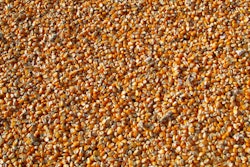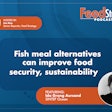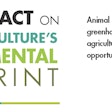The soaring price of feed grains are an evergreen concern for the global animal feed industry. The cost of protein sources, such as soybean meal and fishmeal, has reached unprecedented levels, putting a strain on profitability. In response to this challenge, nutritionists work to discover innovative strategies and utilize alternative ingredients to reduce costs without compromising the nutritional needs of animals.
Rob Patterson,CBS Bio Platformsvice president of innovation and commercialization, joins the Chat to explore tactics to combat anti-nutritional factors related to alternative protein sources.
Transcription of Feed Strategy Chat with Rob Patterson, vice president - innovation and commercialization, CBS Bio Platforms
Jackie Roembke, editor in chief, WATT Feed Brands/Feed Strategy:Hi, everyone. Welcome to Feed Strategy Chat. I’m your host, Jackie Roembke, editor in chief of WATT Feed Brands and Feed Strategy magazine.
This edition of Feed Strategy Chat is brought to you by WATT Global Media and FeedStrategy.com. FeedStrategy.com is your source for the latest news and leading-edge analysis of the global animal feed industry.
Today, we're joined on Zoom by Rob Patterson, vice president of innovation and commercialization withCBS Bio Platforms. He's here today to discuss risingsoybean meal (SMB) costsand explore potential risks of utilizing alternative ingredients in your rations.
Hi, Rob, how are you today?
Rob Patterson,vice resident of innovation and commercialization, CBS Bio Platforms:I'm great, Jackie.
Roembke:Excellent. Well, let's get right into it.Please describe the market trends driving the increased demand for alternative protein sources.
Patterson:What we're seeing lately is near-historic rises in soybean meal prices here in North America, as well as around the world. You know, soybean meal is a base protein ingredient in feed, so as it goes up, it's a rising tide that pulls the price of other ingredients up along with it.
Not only is soybean at record highs, but we're also seeing other ingredients that would be used in rations for protein sources, such as canola meal and other ingredients, also going up. It's really historic and unprecedented since I've been around.
Roembke:Thank you for those insights.What challenges do feed producers typically face when they're utilizing alternative ingredients?
Patterson:There's a lot of different challenges. The most important one I would say is familiarity — and it kind of has two different angles.
First, familiarity with the ingredient in terms of the composition. These ingredients tend to not be as consistent in their nutritional value as classic soybean meal, as you know, solvent-extracted soybean meal. So thinking about extruded soybean meal — or extruded soybeans or toasted soy — every batch is different, and every manufacturing site tends to be a little bit different. The feed mill that receives those ingredients has to be familiar with where it's coming from. Fluctuation from manufacturer to manufacturer is really a big challenge.
The second challenge when it comes to familiarity is familiarity with how to handle those ingredients. Soybean meal is basically the same around the world — how it flows, its bulk density, roughly speaking is pretty similar. When you start looking at these alternative ingredients, the consistency in how to handle it is different. So sometimes they'll have higher fat than others, sometimes it'll be lower protein, and all this kind of contributes to how the mill manages the handling and the utilization of those ingredients.
Roembke:Very good. And if you're going to drill down a little further,are there nutritional challenges? Can you explain a little bit more about what that might look like?
Patterson:The thing with soybean meal is that it is a base level ingredient — everyone's been trained from the nutrition side to understand the crude protein levels of soybean, the amino acid digestibilities, the fat levels and how to formulate it into a diet.
You know, on a broiler diet, it's pretty standard, the amount of soybean meal that goes in it is similar for turkeys. It's a little bit higher, of course, higher-protein diets, but roughly speaking, it's the same across the world — whether you're formulating in North America or Europe.
When you start looking at these alternative ingredients, focusing on soy, you can have soy-extruded "soy manufacturer A" and then it'll have a certain crude protein, a certain fat level, and it has a limited ability to produce. A nutritionist has to get used to using that one source for a certain amount of time, and then they'll have to flip back and forth. Meanwhile, Producer B might have a different amount of protein, a different amount of fat, and so that means those rations have to flip back and forth.
This is a challenge from a nutritionist's standpoint formulating those rations. It's a challenge from a purchaser standpoint because those ingredients are going to have different price points, which is going to drive the landed cost of those ingredients and that's going to drive the least cost formulation system. And we can't forget the production side of things, the people that actually produce the feed. Some of those different ingredients will have different handling characteristics — it'll be harder to unload, sometimes it comes in bag, sometimes it comes in totes.
All these sorts of things have to come into play when making a decision about alternative soybean-based protein ingredients for for animal feeds.
Roembke:在性能方面,如何探索消化stibility and other potential obstacles?
Patterson:Way back when, rations were formulated versus soybean meal. And so an alternative ingredient was always kind of compared to soybean meal, soybean meal being the gold standard. When you start looking at these alternatives soy, i.e. soy extruded and toasted soy, the digestibility just isn't there. It's really driven by a number of factors. It can be driven by the presence of fiber, fiber and those ingredients impedes digestibility of protein.
但是你也可以抵消组件well. If it tends to be high in residual fat, that could offset the performance that you get in the animal from that lower protein digestibility. This interplay between that fiber content, fat content and reduced protein all has to be considered when putting these ingredients together.
I'm from Canada so I have to mention canola meal, which is our big swap for soybean meal. Canola meal coming in (to the ratio) as an alternative, not 100%, but in a lot of cases 50%, 75%. You find lower crude protein, the amino acid profile is a little bit different, higher fiber, comparable on fat, but at that base level amino acid digestibility, you know, the nutritionists have to balance that as well. It all comes into play when you're trying to deliver the least-cost solution for the customer, which is ultimately the producer.
Roembke: Please describe any anti-nutritional factors that may come into play.
Patterson:That's a good question. My answers has been really focused on that nutritional difference between soybean meal and the comparative swaps for that. But when we're looking at soybean, we can't forget about the nutritional factors and then the key one that everyone talks about is trypsin inhibitor.
Trypsin inhibitors are an herbivore-based, a protective mechanism for that plant to protect against animals that would otherwise consume them in the wild. And what it does is it impedes the function of trypsin itself. The reduction in trypsin in the gastrointestinal tract leads to less protein digestibility and it really leads to reduced digestion, and that can reduce performance overall.
Roembke: And for those who may not be familiar, what is trypsin and what is its function?
Patterson:If you do a deep dive, trypsin is a digestive enzyme that's present in that small intestine. Ultimately, it's derived from the pancreas so the pancreas secretes this trypsin in a first form, and then the technicalities as it gets converted into trypsin that's active and Its job is to break down large proteins in the small intestine into their amino acids.
By doing that, the animal absorbs those amino acids and peptides. It doesn't absorb the whole protein. So the trypsin really breaks the proteins down that the animal consumes into the amino acid form, facilitating greater absorption. Greater absorption of those proteins is where our lean tissue growth really comes from.
Roembke:Excellent. Thank you so much for that explanation. Now,how do feed producers reduce their exposure to those trypsin inhibitors?
Patterson:Right. When you're looking at soybeans, traditionally, those trypsin inhibitors have been managed through heat processing. So if you think about the crushed facility: the raw soybean meals come in from a rail car or truck or whatever they are, and they go through that processing facility and heat is as applied to the beans as well as solvent. That solvent is heated as well.
The contact that the soybeans, the raw beans, get from the heat of the solvent, as well as the heat of the processing, denature the trypsin inhibitors. There's a flip to that we can over process, and that's called heat damage. So that renders those proteins unavailable. But the large-scale soybean manufacturers do a really good job at managing that amount of temperature, so that they're deactivating the trypsin inhibitors to a level that's acceptable for the industry writ large.
Roembke: Anything that we maybe didn't touch on that you'd like to emphasize or did we cover the key issues?
Patterson:I would just like to add that when you're looking at these alternative soy-based proteins, so derived from soybean meal, but not going through that conventional solvent extraction process. What you do see is these facilities are a little bit lower in scale, lower in volume, and the ingredients coming out of a mid- or small-sized extrusion facility tend to have higher amounts trypsin, residual trypsin in them. It's not the fault of the manufacturer — it's just a question of scale.
When producers are looking at these alternatives — extruded soy or expelled soy, toasted soybeans — compared to conventional soybeans, the trypsin inhibitor tends to be quite a bit higher. This is just one of those variables I would recommend that nutritionists keep an eye on, feed mill manufacturers keep an eye on, because you're doing your best job to reduce cost and deliver a high-quality ration, but sometimes inadvertently, we could be introducing higher trypsin inhibitor levels than we otherwise would have thought we would have.
Roembke:Excellent. Thank you so much for those insights. Now, if you'd like more information about CBS Bio Platforms, visitcbsbioplatforms.com. Thanks again, Rob. And thanks to you for tuning in.





















